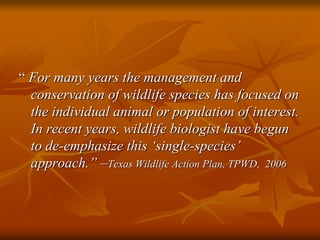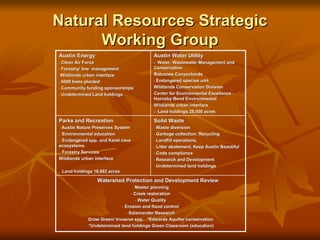Natural Areas Strategic Planrev1
- 1. Natural Resources Strategic Planning Louis Rene’ Barrera, Environmental Conservation Information Specialist Natural Resources Division Austin Nature Preserves System Parks and Recreation Department City of Austin, Texas
- 2. We live, work and recreate in a “dynamic” natural world How well do we manage natures inherent, functional values or ecosystem services? How well do we sustain habitat for a full range of native plant and wildlife communities? How well do we identify, establish, maintain and restore biological diversity, ecologically viable natural areas, conservation easements and or green infrastructure? Do we share a common strategy when managing our natural resources?
- 3. We consider the impact on the environment in everything that we do. (City of Austin’s Green Vision)
- 4. Sustainable community “ Long-range growth plans that support Council's priority of building a sustainable community are managed primarily by Economic Growth and Redevelopment Services, the Neighborhood Planning and Zoning Department and the Watershed Protection Department. The City's utility companies also contribute to this priority through the development and implementation of long-range strategic plans that emphasize conservation and environmental protection.” COA council priority
- 5. Living Systems We all share responsibility as natural resources stewards and recognize that air, land and water are interconnected in sustaining all life, in protecting public health and in achieving healthy, biologically diverse ecosystems and the sustainable economies that depend on these ecosystems. *
- 7. 19 90 $- - $200,000.00 $400,000.00 $600,000.00 $800,000.00 $1,000,000.00 $1,200,000.00 $1,400,000.00 $1,600,000.00 $1,800,000.00 $2,000,000.00 19 1 9 91 91 19 -1 9 92 92 - 19 1 9 93 93 19 -1 9 94 94 19 -1 9 95 95 19 -1 9 96 96 19 -1 9 97 97 - 19 1 9 98 98 19 -1 9 99 99 - 20 2 0 00 00 20 -2 0 01 01 - Budget by Fiscal Year 20 2 0 02 02 20 -2 0 03 03 - 20 2 0 Budget Snapshot 04 04 20 -2 0 05 05 - 20 2 0 06 06 -2 00 7 BCP ANPS
- 8. 19 90 0 1 2 3 4 5 6 7 8 9 10 11 12 13 14 15 16 17 18 - 19 1 99 91 1 - 19 1 99 92 2 - 19 1 99 93 3 - 19 1 99 94 4 - 19 1 99 95 5 - 19 1 99 96 6 - 19 1 99 97 7 - 19 1 99 98 8 - 19 1 99 99 9 ANPS FTE - 20 2 00 00 0 - 20 2 00 01 1 - BCP FTE 20 2 00 FTE’s 02 2 - Number of Employees 20 2 00 03 3 - 20 2 00 04 4 - 20 2 00 05 5 - 20 2 00 06 6 -2 00 7
- 10. Fragmented
- 11. Ecosystems do not understand… Jurisdictions, watershed boundaries, agencies, departments, zoning, or individual species…
- 12. “ For many years the management and conservation of wildlife species has focused on the individual animal or population of interest. In recent years, wildlife biologist have begun to de-emphasize this ‘single-species’ approach.” –Texas Wildlife Action Plan, TPWD, 2006
- 13. Managing Natural Resources as… ECOSYSTEMS
- 14. Organizational Alignment Let’s develop an organizational structure that helps our staff, individual departments, independent organizations and citizens fulfill Austin’s “Green” mission.
- 15. Interdisciplinary Approach Ecosystem Strategy Facilitates the enhancement and restoration of biological diversity. Utilizes sustainable land management performance guidelines and measures. Fosters ecological stewardship and intergenerational sustainability. Focuses on “Ecosystem- based” management principles.
- 18. Sustainability based performance measures Core vs. semi core… that is the question! Focus on measurable goals that specify future processes and outcomes necessary to maintain sustainable environments. Restores and conserve structural complexity which strengthen ecosystems from natural disturbance and produces genetic resources necessary to adapt to long term change. Focus on intergenerational sustainability
- 19. “The goal of Ecosystem-based management is to maintain the health of the whole as well as the parts.” -Pew oceans report 2003
- 20. Land Conserve and restore representative examples of Central Texas ecosystems and enhance native biological diversity. Protect natural ecological processes, community structure and natural functional values. Serve as sanctuary for resident and migratory wildlife. Protect rare threatened and endangered species and preserve their communities structural requirements. Enhance opportunities for natural resource based recreation, education and stewardship.
- 21. Air Develop and implement programs that reduce the impact of human activities on regional air quality; Promote air quality education and outreach to citizens and local businesses Work with regional partners to promote healthy air in Central Texas. Increasing the capacity of natural areas and green infrastructure to sequester carbon. Enhance opportunities for natural resources based recreation, education/ research and stewardship.
- 22. Water Conserve and sustain representative examples of aquatic communities, and their representative ecosystems. Protect water quality and quantity, including seeps, springs, corridors, ground water recharge zones and aquifer levels. Protect rare threatened and endangered aquatic species and their habitats Enhance opportunities for natural resource based recreation, education/ research and stewardship.
- 23. Wildlife Help sustain viable populations of native and migratory species that are representative of our region. Maintain integral species processes, pollinators, seed dispersal, herbivorery Provide opportunities with minimal disturbance and or human influences. Protect rare threatened and endangered species and their habitats. Enhance opportunities for natural resource based recreation, education/ research and stewardship.
- 24. Energy A commitment to prudently explore solar and other emerging energy technologies Advances the development of a local clean energy industry. Continues to restore urban forestry to mitigate affects of Heat Island Increase the capacity of natural areas and green infrastructure to sequester carbon. Enhance opportunities for natural resource based recreation, education/ research and stewardship.
- 25. Waste Develop and implements programs that reduce the impact of human activities on the environment. A commitment to prudently explore solar and other emerging energy technologies Provide environmentally safe removal of hazardous materials from waste stream. Provide disposal and waste diversion services in order to protect the environment and conserve resources. Provides R & D in order to maximize waste diversion.
- 26. The sum of the parts…
- 27. Natural Resources Strategic Working Group Austin Energy Austin Water Utility Parks and Recreation Solid Waste Watershed Protection Any others?
- 28. Natural Resources Strategic Working Group Austin Energy Austin Water Utility ? Clean Air Force Water, Wastewater Management and ? Forestry/ line management Conservation Wildlands urban interface Balcones Canyonlands ? 6000 trees planted ? Endangered species unit ? Community funding sponsorships Wildlands Conservation Division ? Undetermined Land holdings Center for Environmental Excellence - Hornsby Bend Environmental Wildlands urban interface Land holdings 28,000 acres Parks and Recreation Solid Waste Austin Nature Preserves System ? Waste diversion Environmental education ? Garbage collection; Recycling Endangered spp. and Karst cave ? Landfill operations, ecosystems. ? Litter abatement, Keep Austin Beautiful Forestry Services ? Code compliance Wildlands urban interface ? Research and Development ? Undetermined land holdings Land holdings 16,682 acres Watershed Protection and Development Review ? Master planning ? Creek restoration ? Water Quality ? Erosion and flood control ? Salamander Research Grow Green/ Invasive spp. *Edwards Aquifer conservation *Undetermined land holdings Green Classroom (education)
- 29. Equals the whole Photo by John Ingram 2004, Indiangrass Wildlife Sanctuary
- 30. What are the next steps? ___________________________________ ___________________________________ ___________________________________ ___________________________________
- 31. “Treat the Earth Well: It was not given to you by your parents. It was loaned to you by your children. We do not inherit the earth from our Ancestors, we borrow it from our Children.” —Ancient Indian Proverb































